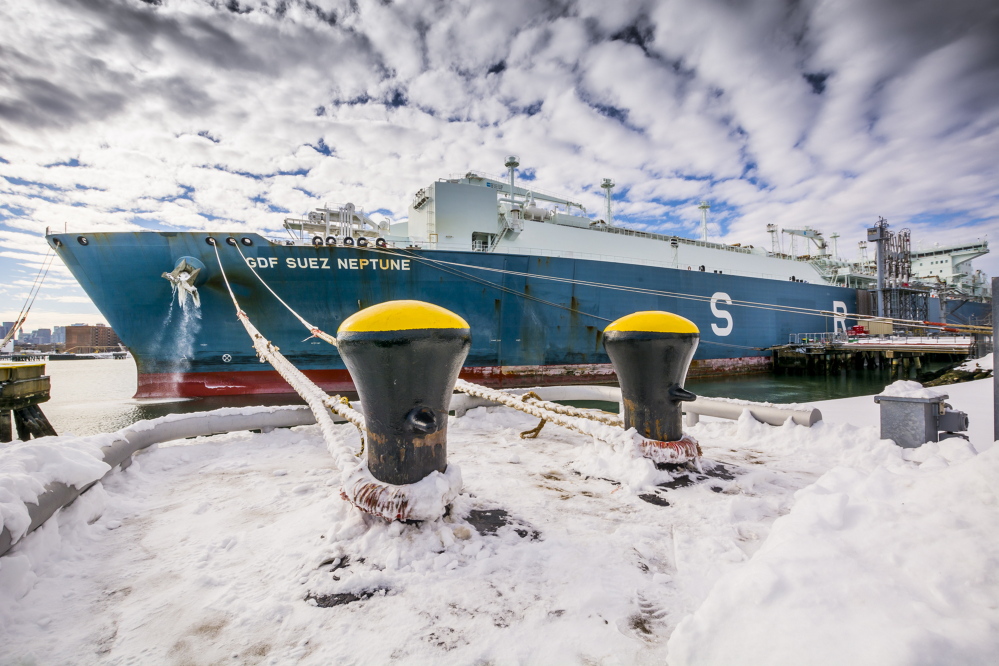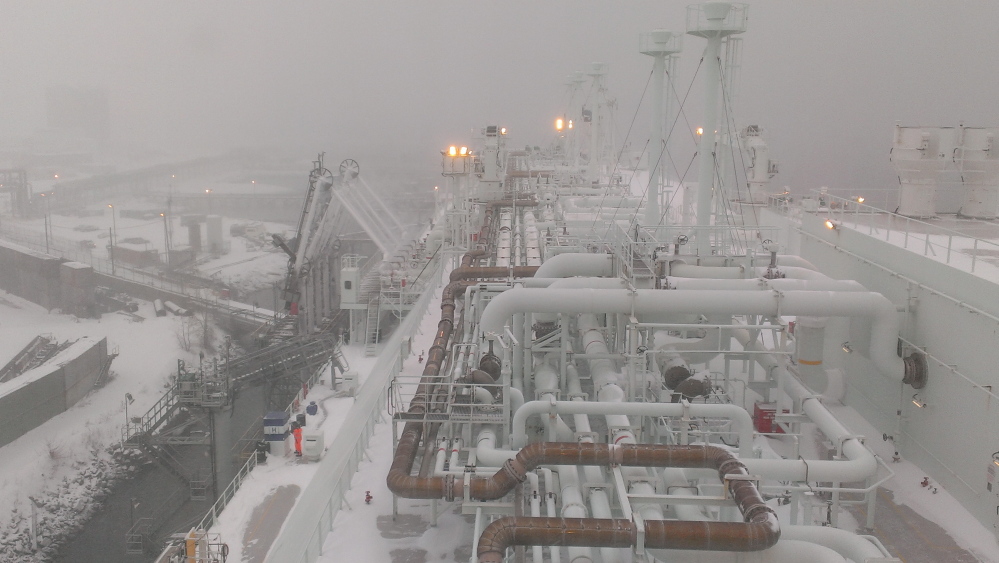A tanker offloaded enough liquefied natural gas at Boston Harbor last week to heat 30,000 homes for a year, bolstering New England’s tight pipeline capacity just as a new wave of below-average temperatures threatens to strain energy supplies.
But some advocates say this strategic slug of LNG during the coldest days of the winter can do more: It may help lower wholesale power prices from Connecticut to Maine, helping to hold down the cost of electricity for homeowners and businesses.
That’s a debatable claim, but it highlights the intensifying dispute over whether New England power customers should spend billions of dollars to expand the region’s natural gas pipeline network, or whether market forces – such as ships filled with imported LNG – can be counted on to provide less costly, interim solutions.
The answer to that question matters in Maine. State utility regulators are considering a plan to charge electric customers up to $75 million a year for 20 years to help increase the supply of natural gas, if it looks like the investment would pay for itself quickly in lower electric rates.
Pipeline opponents say the investment isn’t needed. They say a surge of imported LNG arriving in New England this winter is contributing to the unanticipated decline in electricity rates. Using LNG and oil, they say, can buy time for smaller, privately funded pipeline expansion projects to boost the region’s gas supply. Two such projects are set to begin pumping in 2017.
Last Sunday, the GDF Suez Neptune arrived in Boston Harbor from Trinidad and Tobago with 3 billion cubic feet of LNG. It was the second cargo the ship had delivered since early January to the GDF Suez terminal in Everett, Massachusetts.
LNG cargoes into the region are at their highest levels in three years. One of the two Massachusetts offshore, floating LNG terminals, Excelerate’s Northeast Gateway project, handled its first delivery since 2010.
PREVENTING SPIKES IN PRICES
These deliveries are happening because New England – oddly – has better prices for LNG suppliers this winter than Asia or Europe. The result is that imported LNG, driven down in price by the collapse of crude oil, is suddenly competitive in New England with domestic natural gas.
LNG is bringing lower-cost supply when it’s needed most for space heating and manufacturing, and for gas-fired power plants, which produce half the electricity in New England. That’s helping to keep gas and wholesale electric prices from spiking to record levels, as they did last winter.
Cheap and plentiful natural gas from domestic fields had all but priced LNG out of the market here. Its resurgence now adds more confusion to New England’s already-fractured energy policy.
Lower-cost LNG challenges the narrative – voiced loudly by Gov. Paul LePage, some Maine manufacturers and, most recently, the operator of New England’s power grid – that the only reliable way to lower electric rates is to build massive amounts of new gas pipeline capacity. Doing that, they say, could lower New England prices to levels enjoyed by gas-producing regions.
To pipeline supporters, this winter’s decline in electric rates is a one-time, lucky break. World LNG prices track crude oil, they say, so LNG will get expensive again when oil recovers.
“The only reason we’ve had so much LNG this year in New England is global prices are better here than in Asia,” said Tony Buxton, a Portland lawyer. He represents many industrial gas customers in Maine, as well as the Tennessee Gas Pipeline, which wants to build a major expansion through Massachusetts and New Hampshire. Buxton said LNG shouldn’t get credit for narrowing the price gap – called the basis differential – between what New England and the Southern states pay for wholesale gas.
“I don’t think LNG has kept the basis down,” he said. “What’s driving it is the price of oil.”
PIPELINE, LNG ADVOCATES AT ODDS
Pipeline supporters got a boost last month during a news conference held by ISO-New England, the regional electric grid operator. Gordon van Welie, the company’s president, said there was an “urgent need” for more gas capacity, despite the easing of prices this winter. He warned that Greater Boston could suffer reliability problems as soon as 2016 if pipeline and other investments aren’t made.
“The question for the states is whether the pipeline investment can be recouped in lower energy prices,” he said. “The data shows that it should be possible to do that.”
Not surprisingly, LNG interests dispute this idea.
Frank Katulak, president of GDF Suez subsidiary Distrigas of Massachusetts, said $5 billion to $6 billion worth of expansion projects would be borne by New England ratepayers every day for up to 20 years.
“Why does it make sense to build and scale pipelines to meet demand peaks 30-40 days of the year?” he said in a recent op-ed column.
Katulak also raised the possibility that ratepayer-financed pipelines could be used to export gas overseas. Notably, both the existing Canaport LNG terminal in Saint John, New Brunswick, and a proposed terminal at Robbinston, in Washington County, seek to both import and export gas.
LNG’s benefits are providing a talking point for environmental groups that oppose large-scale pipeline expansion. They fear that increasing the region’s reliance on natural gas to make electricity will contribute to climate change and push out wind, hydro and other renewable energy options.
‘THIS BUYS US SOME TIME’
Greg Cunningham, a senior attorney at the Conservation Law Foundation, said LNG can help fill the gas supply gap for the next couple of years, until smaller pipeline expansions are built. The additional gas will shrink the price difference between regions from 2017 to 2020, studies show, when more renewables can come on line.
“This buys us some time for the best solutions and avoids overinvesting with ratepayer money,” Cunningham said.
Buxton, however, said environmental groups are being hypocritical, because they’ve been fighting LNG terminals for years, including proposals in Maine. Cunningham responded that his group doesn’t support new terminals, just better use of the three existing facilities in Massachusetts and the one in Atlantic Canada.
“We don’t need new facilities,” he said. “We just need to make better use of them.”
LNG deliveries during the first three weeks of January were up more than three times over last year at terminals in Massachusetts and Maryland, according to the U.S. Energy Information Administration. That has caught the attention of experts who follow global energy industries. At least one of them says residents here shouldn’t count on a repeat next winter.
“My gut says this is a temporary event,” said Rick Margolin, a senior analyst at Genscape, a Boston energy markets data firm.
Margolin, who wrote a recent blog about how LNG was holding down New England’s wholesale price spikes, noted that a cool summer and slowing economy in Asia contributed to low demand in a normally robust global market for gas. So when LNG suppliers were looking for the best place to sell gas this winter, they were attracted by the higher contract prices and demand in New England.
But if crude oil prices recover, he said, that will tend to drag up the prices of LNG.
“I think that was an aberration,” he said, referring to this winter’s attractive LNG prices. “Going forward, I don’t think so.”
Send questions/comments to the editors.




